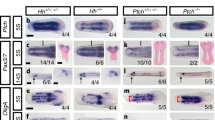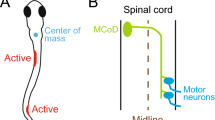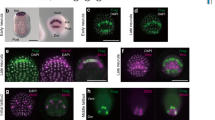Abstract
IN the spinal cord of larval Anura, the motor cells which innervate the muscles of the hind limbs form ventral horns distinct both in position and time of appearance from the series of primary motor cells whose axons run to the trunk muscles. In the tadpole of Xenopus laevis, there are about 4,000 ventral horn cells at the time of their differentiation from the mantle layer of the cord, a number which has fallen to 1,200 by metamorphosis some eight weeks later1. ‘Histogenic cell degeneration’2 accompanies the differentiation of these neurones, but on a scale much beyond that required merely to reduce their number to the adult-level. It seems that, for every ventral horn cell that persists, some eight or nine undergo cell death during development. Differentiation of the ventral horn is thus accompanied by a continuous turnover of the constituent neuroblasts.
This is a preview of subscription content, access via your institution
Access options
Subscribe to this journal
Receive 51 print issues and online access
$199.00 per year
only $3.90 per issue
Buy this article
- Purchase on Springer Link
- Instant access to full article PDF
Prices may be subject to local taxes which are calculated during checkout
Similar content being viewed by others
References
Hughes, A. F. W. (to be published).
Glucksmann, A., Biol. Rev., 26, 59 (1951).
Lewis, P. R., Bibl. Anat., 1 (1961).
Shute, C. C. D., and Lewis, P. R., see preceding communication.
Author information
Authors and Affiliations
Rights and permissions
About this article
Cite this article
HUGHES, A., LEWIS, P. Effect of Limb Ablation on Neurones in Xenopus Larvæ. Nature 189, 333–334 (1961). https://doi.org/10.1038/189333a0
Issue Date:
DOI: https://doi.org/10.1038/189333a0
Comments
By submitting a comment you agree to abide by our Terms and Community Guidelines. If you find something abusive or that does not comply with our terms or guidelines please flag it as inappropriate.



